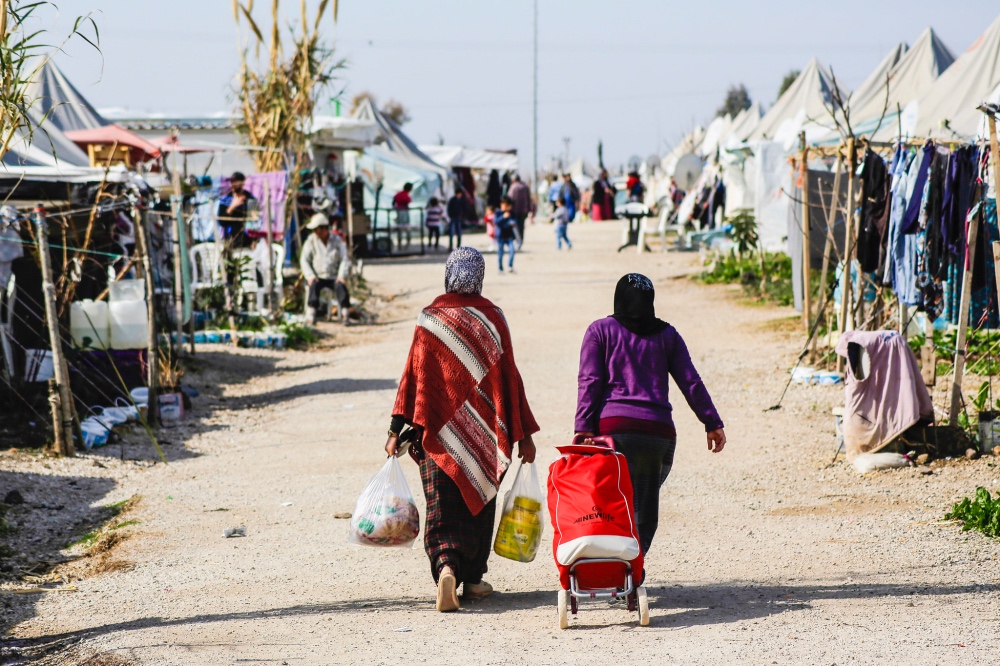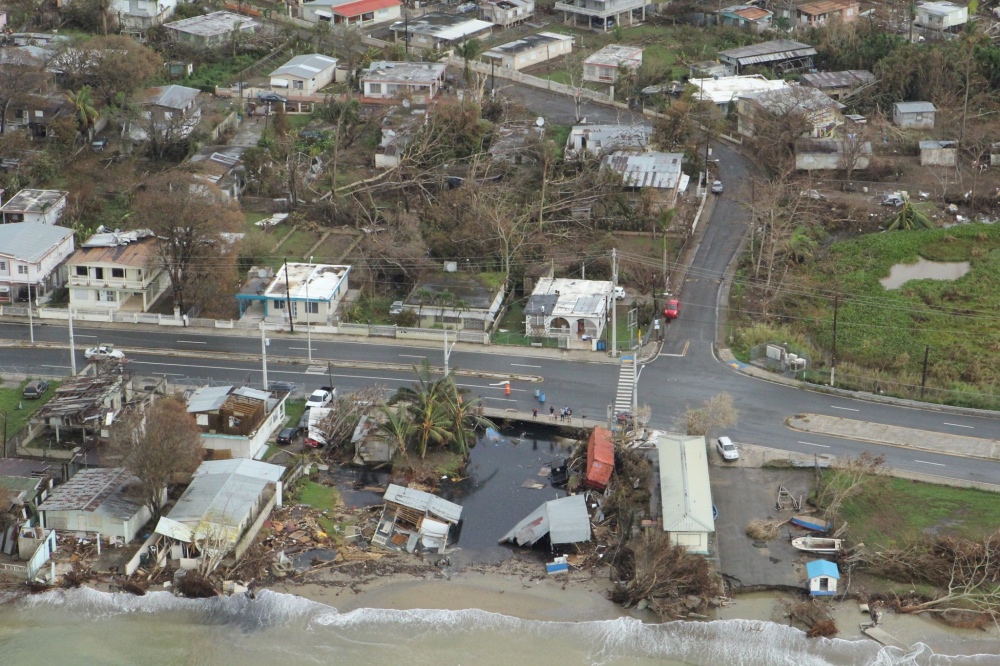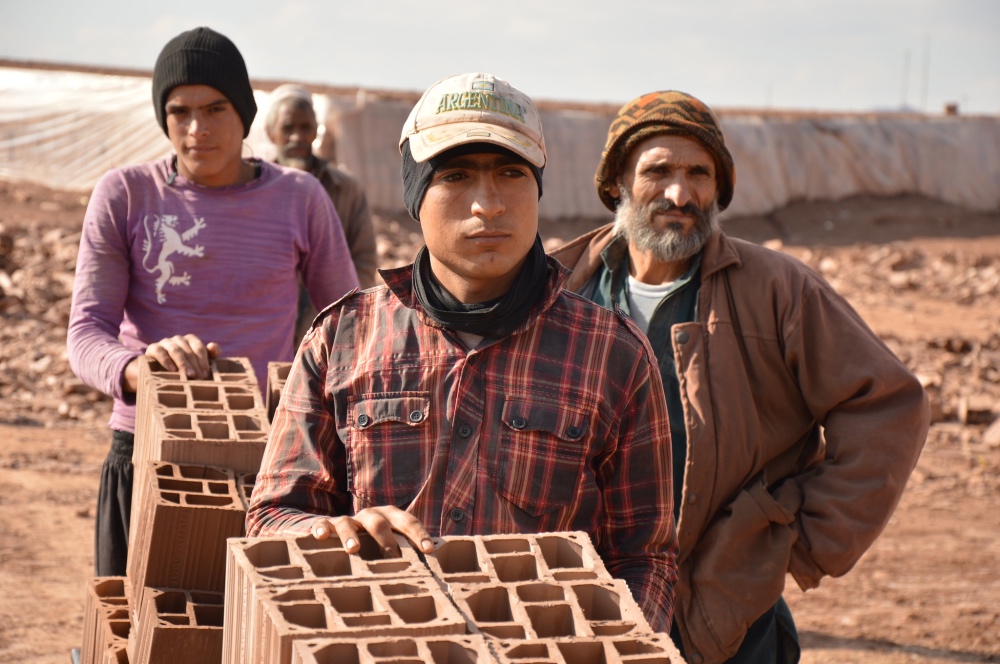
RINA CHANDRAN, of Thomson Reuters Foundation, reports on how new technologies are being employed in the fight for land rights for those without formal documentation…
Bangkok, Thailand
Thomson Reuters Foundation
When Hurricane Maria struck Puerto Rico in 2017, the Category 5 storm destroyed and damaged thousands of homes, yet about 60 per cent of housing aid claims were denied because residents could not prove their ownership or occupation.
In the US territory, inheritance bequests were traditionally informal agreements, and only homeowners with a mortgage or a condominium had a title. Many dwellings were informally built, and had no documents.

Destruction in Puerto Rico after Hurricane Maria, seen from a US Coast Guard MH-60 Jayhawk helicopter on 29th September, 2017. PICTURE: Coast Guard Auxiliarist Vicente Vélez/US Coast Guard.
The US Federal Emergency Management Agency eventually agreed to accept sworn affidavits instead of titles, but the crisis underscored the need for alternative ways to prove property rights apart from formal documentation.
“The reality of our property rights is evidenced in everyday events: where we sleep at night, where our mail is delivered, the fact that we paid to put a new roof on our house,” said Yuliya Panfil, property rights director at the thinktank New America.
“The reality of our property rights is evidenced in everyday events: where we sleep at night, where our mail is delivered, the fact that we paid to put a new roof on our house. These small events, in aggregate, form a more accurate picture of reality than the credentials used by administrative agencies. With smartphones and social media, they also leave a data trail that can be used to prove property rights”
– Yuliya Panfil, property rights director at the thinktank New America.
“These small events, in aggregate, form a more accurate picture of reality than the credentials used by administrative agencies,” she said.
“With smartphones and social media, they also leave a data trail that can be used to prove property rights.”
Globally, more than 70 million people have been forced from their homes by wars, natural disasters and other events, according to the United Nations. To return to their land and homes, they usually need to show documentary proof.
But more than two-thirds of the world’s population does not have a legal title to their land, which makes it harder to return after a displacement or to receive compensation after a disaster.
The way in which property rights of the displaced are determined needs to account for technological advances, said Jon Unruh, an associate professor at McGill University who studies land rights of war-affected populations.
“Dislocated populations seeking to return to their homes face significant problems as they usually have only partial, non-relevant or informal documents – if they have any at all,” he told the Thomson Reuters Foundation.
“With the significant advances in socio-spatial technologies, and the abilities of displaced populations with regard to their use of mobile digital technologies and social media, an upgrade is important,” he said.

Afghan refugees in Iran, seen on 24th November, 2013. Dislocated populations returning home can face significant problems in claiming property rights due to a lack of formal documentation, according to Jon Unruh, an associate professor at McGill University. PICTURE: EU/ECHO Pierre Prakash (licensed under CC BY-NC-ND 2.0)
More than three billion people, or about 40 per cent of the world’s population, use a smartphone, according to data portal Statista.
The rapid growth in the use of smartphones has revolutionised the way people communicate, make payments and access public and other services.
Use of mobile apps such as Google Maps, M-Pesa and Uber also generate evidence of where one lives and what one purchases.
Photographs and posts on social media of homes, and announcements of a purchase or a move can be a form of proof of where someone lived, said Panfil, adding that banks have long accepted many ways to prove credit worthiness, for example.
“Formal property rights is a government-led function, so we have been stuck with the same systems, and proving someone’s property rights depends on what’s acceptable or not to the government agency,” she said.
“Digital trails can upend traditional power structures and give power back to the people somewhat.”
– Yuliya Panfil.
“Digital trails can upend traditional power structures and give power back to the people somewhat,” she said.
Across the world, land is seen as a root cause of conflict.
Dysfunctional legal systems, corruption, lack of transparency and accountability, and the loss of documents and land records make it particularly hard to resolve land disputes during and after a war, according to researchers.
In Colombia, where up to 15 per cent of territory has been abandoned or illegally acquired by leftist rebels and paramilitary groups during the country’s five-decade war, millions cannot return to their homes because they cannot prove they had once occupied them.
About 93 per cent of Syrian refugees do not have formal housing documentation, while 57 per cent of internally displaced Iraqis do not have property documents, according to data cited by Unruh.
Yet more than 60 per cent of displaced Iraqis used digital tools like Facebook and messaging apps to monitor the homes they had fled, a 2017 study showed. About 32 per cent shared information about the status of their properties on social media.
That evidence could help speed up the restitution process, lower the cost of processing claims, and reduce the burden on host and displaced populations, said Unruh.
“The effective return of dislocated populations to their homes and land is fundamental to postwar recovery, reconciliation and reconstruction, but the restitution process often does not recognise alternative forms of evidence” he said.
“Consequently, a great deal of properties have not been returned to rightful owners.”

A scene in a Syrian refugee camp in Turkey in February, 2016. It’s estimated that some 93 per cent of Syrian refugees don’t have formal housing documentation. PICTURE: © European Union 2016 – European Parliament (licensed under CC BY-NC-ND 2.0)
With greater use of digital data, there can be concerns around unequal access to technology and privacy, said Panfil, who plans a survey of displaced Iraqis in Kurdistan to gauge if their smartphone use can be directed to make property claims.
“More and more people will have smartphones, and third parties that collect data about us – like Google, Facebook and M-Pesa – must be willing to issue credentials that can be used in establishing property claims,” she said.
“We have to think of what constitutes as proof, and design a digital identity system for land that maximises user privacy and control,” she said.
Another challenge is risk-averse international organisations who operate restitution programmes and process mass claims, said Unruh.
“They can be heavily invested in older ways of doing things. Even though the legal aspects are all in place, and individuals themselves are very keen to use the technology,” he said.
In some parts of the world, authorities are on board.
Colombia is piloting an analytics and mapping software to collect aerial and satellite imagery, interviews and physical evidence to determine ownership of millions of plots of land that were seized during the conflict.
In Nepal, authorities are updating the land policy after the 2015 earthquake that killed thousands and flattened settlements, so technologies such as geographic information system-based mapping can be used to determine occupancy, said Rebecca Ochong of charity Habitat for Humanity.
“For informal settlements and for disaster-prone areas, you need fit-for-purpose land policies that are realistic and flexible, so the most vulnerable including those who are undocumented can access aid and essential services,” she said.
“Technology – even just a smartphone – allows us to do so much now. This is the way to go,” she said.





